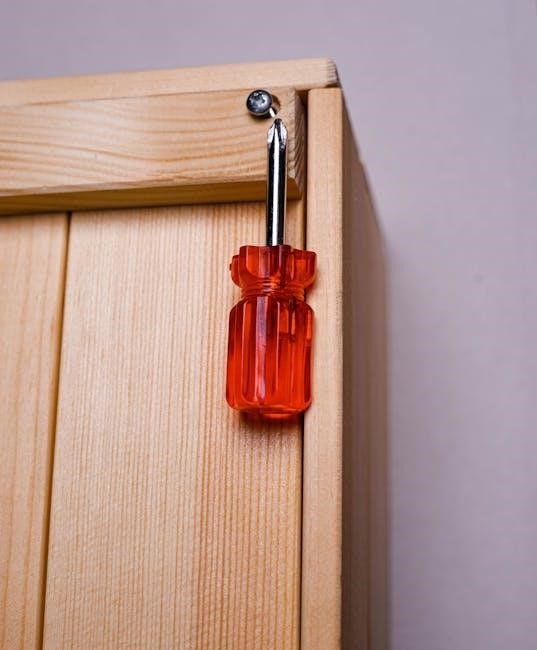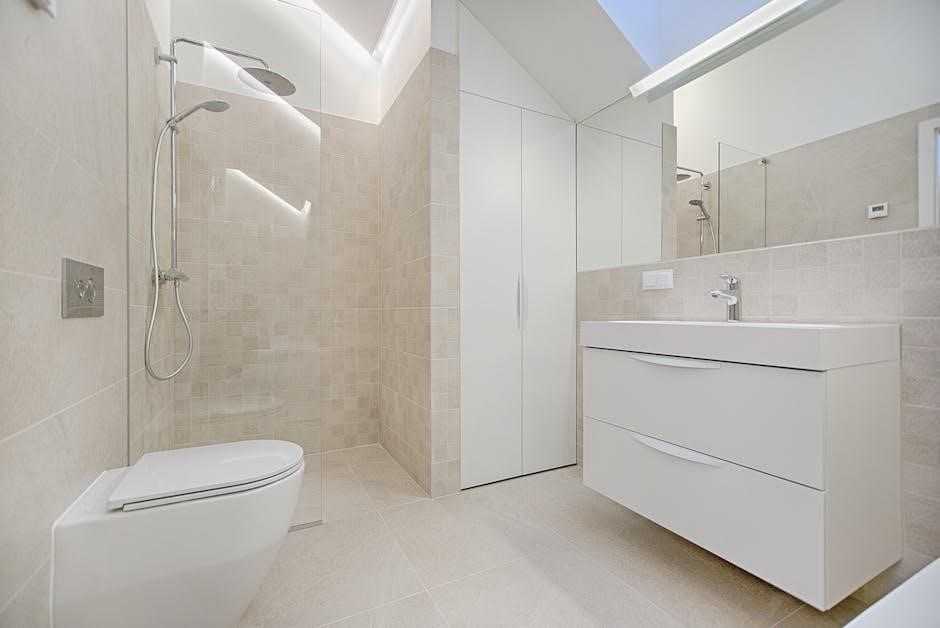rta cabinet assembly instructions pdf

RTA Cabinet Assembly: A Comprehensive Guide
Ready-to-assemble (RTA) cabinets offer an economical and DIY-friendly solution for kitchen upgrades. This guide provides a complete overview, from understanding RTA cabinets to mastering the assembly process.
Understanding RTA Cabinets
RTA cabinets are flat-packed cabinets that you assemble yourself. They are a popular choice for homeowners looking to save money on kitchen or bathroom renovations without sacrificing quality. These cabinets are crafted with quality materials, and while assembly is required, it’s designed to be manageable for DIY enthusiasts. The instructions vary based on the cabinet line and style you select. The savings come from the reduced labor costs associated with pre-assembly. RTA cabinets arrive in individual pieces, including the cabinet box components, doors, drawers, and hardware. This allows for efficient shipping and reduces the risk of damage during transit. Many manufacturers, like RTA Cabinet Store, even offer 3D interactive assembly instructions via apps like BILT, making the process even more straightforward. With a bit of patience and the right tools, assembling RTA cabinets can be a rewarding experience. Choosing RTA cabinets gives you control over the process and allows you to customize your space to your exact specifications, all while staying within your budget. So, embrace the DIY spirit and transform your kitchen with RTA cabinets!

Preparing for Assembly
Proper preparation is key to a smooth and efficient RTA cabinet assembly. This includes careful unboxing and inspection of all parts, as well as gathering the necessary tools and materials for the job.
Unboxing and Inspection
The first step in preparing for assembly is carefully unboxing all the RTA cabinet components. Before discarding any packaging, take a complete inventory of all parts listed in the assembly instructions. This includes cabinet boxes, doors, drawers, hardware (screws, hinges, brackets), and any additional accessories. Lay out all wooden panels on a soft, protective surface like a blanket or cardboard to prevent scratches. Thoroughly inspect each piece for any signs of damage that may have occurred during shipping. Pay close attention to edges, corners, and finished surfaces. Note any crushed boxes, holes, or torn cardboard on the delivery Bill of Lading. Check for defects such as dents, scratches, or missing veneer. Verify that all screws, brackets, and hinges are included and compatible with your cabinet design. It’s crucial to identify any damaged or missing parts before you begin assembly to avoid delays and ensure a successful project. Contact the manufacturer or retailer immediately if you find any discrepancies or damage. Document everything with photos if possible, as this will be helpful when requesting replacements. Do not proceed with assembly until you have all the necessary parts in good condition. This proactive approach saves time and frustration in the long run.
Tools and Materials Checklist
Having the right tools and materials on hand before starting your RTA cabinet assembly is crucial for a smooth and efficient process. This checklist ensures you’re well-prepared: Essential Tools: A power drill or drill/driver with various bits (Phillips head, flat head, and possibly a square drive) is essential for screwing components together. A rubber mallet is useful for gently tapping pieces into place without causing damage. A level (both a standard and a small torpedo level) ensures cabinets are installed straight and plumb. A measuring tape is needed for accurate measurements and alignment. A square helps ensure corners are square and joints are aligned correctly. A utility knife is useful for opening boxes and trimming excess material. A damp rag is needed for wiping away excess wood glue. Recommended Materials: Wood glue is crucial for strengthening joints and ensuring a durable assembly. Use a high-quality wood glue and apply it liberally to all wood joints, including drawer dovetails. Screws (ensure you have extra screws on hand in case of any mishaps). Clamps help hold pieces together while the glue dries. Safety glasses protect your eyes from dust and debris. Work gloves protect your hands and improve grip. A protective layer (such as a drop cloth or cardboard) protects finished surfaces from scratches. Optional but Helpful: A stud finder helps locate wall studs for secure wall cabinet mounting. Shims are useful for leveling cabinets on uneven floors. A pencil is used for marking measurements and guidelines. By gathering these tools and materials beforehand, you’ll be well-equipped to tackle the RTA cabinet assembly process with confidence.

Step-by-Step Assembly Instructions
This section provides detailed, easy-to-follow instructions for assembling your RTA cabinets. We’ll cover both base and wall cabinets, ensuring a sturdy and professional-looking finished product.
Base Cabinet Assembly
Assembling base cabinets is a fundamental step in any kitchen renovation. These cabinets form the foundation of your kitchen design, providing essential storage and countertop support. Before you begin, ensure you have a clear workspace covered with a protective layer to prevent scratches on the finished surfaces. Gather your tools: a drill/driver, rubber mallet, wood glue, and a damp rag for cleaning excess glue. Familiarize yourself with the cabinet components and the assembly instructions specific to your cabinet line and style, as instructions vary. Start by laying out all wooden panels on a soft surface. Separate the top panel from the bottom panel. Apply wood glue to all wood joints, including drawer dovetails, before assembly. Excess glue should be cleaned before drying. Follow specific glue recommendations. Secure the sides to the base using screws or metal clip locks, following the manufacturer’s instructions. Repeat this step for each cabinet you are assembling. Next, insert the shelves into the cabinet, making sure they are secure. Then, attach the back panel to the cabinet using screws or nails, following the manufacturers instructions. This will add stability to the cabinet structure. With RTA Cabinet Store cabinets, the assembly is easier than you think. Go from DIY novice to renovation expert with our helpful assembly resource guide. Skip the guessing game of where does this piece go with our interactive. Remember, wall cabinets are easier to assemble than base cabinets because they have no drawers, toe kicks, or corner brackets.
Wall Cabinet Assembly
Wall cabinet assembly is a critical phase in bringing your kitchen design to life, offering elevated storage solutions. Begin by preparing a clean and protected workspace to prevent any damage to the cabinet surfaces during assembly. Gather necessary tools, including a drill/driver, level, wood glue, and a damp cloth for wiping away excess adhesive. Carefully unpack all components, cross-referencing them with the parts list in your assembly instructions, which vary based on the cabinet line and style you selected. Familiarize yourself with the specific instructions for your chosen door style, as this will guide you through each step. Lay out the cabinet sides, top, and bottom panels on your prepared surface; Apply wood glue to all joining edges to ensure a strong and durable bond. Assemble the frame by attaching the sides to the top and bottom panels, using screws or cam locks according to the manufacturer’s guidelines. Ensure the frame is square and level before fully tightening the fasteners. Attach the back panel, which provides structural stability. Use screws or nails, spacing them evenly along the edges. Install any adjustable shelves, making sure they are securely in place. Finally, attach the doors, aligning them properly and adjusting the hinges as needed for smooth operation. Remember to clean any excess glue immediately to maintain a professional finish. RTA Cabinet Store is pleased to bring you 3D interactive assembly instructions with the BILT App for ready to assemble cabinets in our Quick Ship program. The instructions for the cabinet SKUs shown below are applicable to all the Quick Ship Cabinet lines.

Utilizing 3D Interactive Instructions
Step away from confusing diagrams! Interactive 3D instructions transform RTA cabinet assembly. Rotate, zoom, and explore each step for unparalleled clarity, ensuring a seamless and error-free building experience.
The BILT App Advantage
The BILT app revolutionizes RTA cabinet assembly by providing interactive, 3D instructions. Say goodbye to confusing paper manuals and hello to a dynamic, user-friendly experience. With BILT, you can rotate and zoom in on each step, ensuring a clear understanding of the assembly process. This eliminates guesswork and reduces the risk of errors. The app’s intuitive interface guides you through each stage, from identifying parts to securing the final screws. BILT also offers helpful tips and troubleshooting advice, making even complex assemblies manageable. Specifically designed for RTA Cabinet Store’s Quick Ship program, BILT provides tailored instructions for each cabinet line. By visualizing the process in 3D, you can confidently tackle your cabinet assembly project. The app’s step-by-step guidance ensures accuracy, while its interactive features keep you engaged. BILT simplifies the entire process, turning DIY novices into renovation experts. Take advantage of this innovative tool to streamline your RTA cabinet assembly and achieve professional-looking results. With BILT, you’ll save time, reduce frustration, and enjoy the satisfaction of building your own cabinets with ease. Accessing these intelligent instructions through the BILT app is free and provides unparalleled support, making your cabinet assembly a truly seamless endeavor.

Troubleshooting Common Assembly Issues
Even with detailed instructions, assembly challenges can arise. One common issue is misidentifying parts. Always double-check part numbers against the manual before proceeding. If a screw strips, try using a rubber band between the driver and screw head for better grip. For panels that don’t align perfectly, loosen adjacent screws and gently realign before tightening. If a cabinet is wobbly, ensure all connections are secure and consider adding shims underneath. Drawers that stick may need adjustment; check the drawer slides and ensure they are properly aligned and lubricated. If a door doesn’t close flush, adjust the hinges until it sits correctly. Missing hardware can halt progress; contact the manufacturer for replacements. Excess glue can be messy; wipe it away immediately with a damp rag. If you encounter difficulty inserting shelves, check for obstructions and ensure the shelf supports are properly installed. Peeling laminate can be addressed with contact cement, carefully applied and smoothed. Warped panels may require clamping during assembly to ensure proper alignment. If the back panel doesn’t fit snugly, carefully trim any excess material. Always refer to the assembly instructions for specific troubleshooting tips related to your cabinet model. Don’t hesitate to seek assistance from online forums or the manufacturer’s support line for more complex issues. Persistence and attention to detail are key to overcoming assembly challenges and achieving a successful outcome.
Tips for a Smooth Assembly Process
Prepare your workspace by laying down a protective layer. Sort all components before starting to ensure easy access. Apply wood glue to all joints for added stability. Don’t rush; double-check each step against the instructions.
Wood Glue Application
The proper application of wood glue is crucial for the long-term durability and stability of your RTA cabinets. Wood glue enhances the strength of joints, preventing wobbling and ensuring a solid, professional finish. Always use a high-quality wood glue recommended for woodworking projects. Before applying glue, ensure that the surfaces are clean and free of dust or debris, as contaminants can weaken the bond. Apply a thin, even layer of glue to both surfaces being joined, covering the entire area. Use a brush or applicator for uniform distribution, paying close attention to edges and corners. After joining the pieces, clamp them securely to maintain pressure while the glue dries, typically for at least 30 minutes to an hour, or as per the glue manufacturer’s instructions. Excess glue that squeezes out should be wiped away immediately with a damp cloth to prevent unsightly residue and ensure a clean finish. For dovetail joints and other intricate connections, ensure glue penetrates all crevices for maximum strength. Avoid using excessive amounts of glue, as this can weaken the joint and create a messy finish. Following these wood glue application guidelines will ensure that your RTA cabinets are sturdy, durable, and visually appealing, providing years of reliable service. Always refer to your specific cabinet’s assembly instructions for any unique glue application requirements.



Leave a Reply
You must be logged in to post a comment.